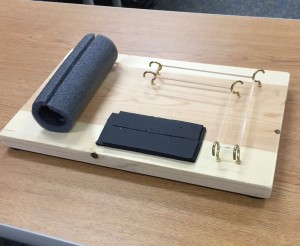For the last several years, we have given a zip-locked bag of surgical instruments, rope, and suture to each M3 student for them to keep for the duration of their clerkship.
The essential contents include:
- Needle Driver
- Forceps with Teeth
- Straight Scissors
- 34″ of nylon, corded rope, 1/4″, with the ends fused
- Suturing material

We also provide them pdf versions the excellent Ethicon Knot Tying and Wound Closure Manuals. Ethicon (a Johnson & Johnson company) has generously provided this resource for the health care professions.
Ethicon ™ Wound Closure Manual
The concept originated as an attempt to improve student surgical skills and surgical instrument exposure.
At our institution, as at many others, there has been a decrease in open abdomen surgical volume. The M3 students, being at the far end of the training continuum, were getting less scrubbed-in time, and less time in the OR for handling surgical instruments.
By providing these basic surgical tools, I hoped the students would play with them, gaining experience in their handling, so that when they are in the OR, they already have many of the basic skills mastered. In this way, they will maximize the educational impact of the time they do spend scrubbed-in.
The rope is to practice knot-tying on a larger scale than suture, so they can easily see what they are doing. After mastering the rope, they can move on to finer suture, tying while wearing gloves, and tying in a slippery setting.
During their initial orientation to the clerkship, students have time set aside for training in knot tying, suturing and stapling. When first starting their training, I have them tying knots on a knot board, with the rope we provided.

After achieving some basic skill in knot tying, I have them move on to suturing.
They begin suturing foam rubber, to develop basic skills and learn to avoid bad habits. Then, I have them move on to sewing chicken wings.
Chicken wings are plentiful and inexpensive. They allow the student to experience the tactile feel of biologic tissue while practicing their suturing.
I also have them work in teams, one student acting as surgeon and the other student acting as the assistant, while closing a laceration. Working with them on good assisting techniques makes the overall surgical experience better.
Finally, I have them work in teams to staple closed the chicken wing laceration.
When they complete this session they are feeling good about their manual skills and are reasonably motivate to practice suturing, using their surgical kits. I see them in Labor and delivery, practicing their knot tying with rope through button holes in their lab coats. I see them suturing two folds in their scrub pants together, and then cutting out the suture. This has been a successful venture.
At the end of the rotation, we collect all the suturing kits. Rarely are any instruments lost (one or two per year), and they are replaced.
